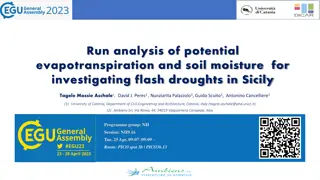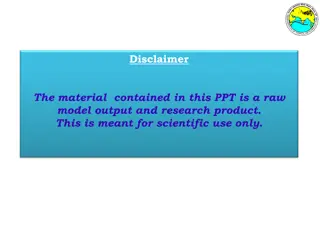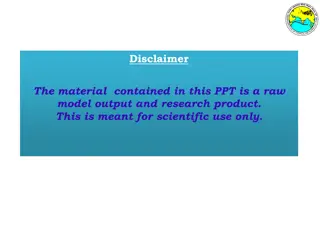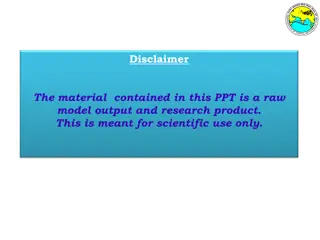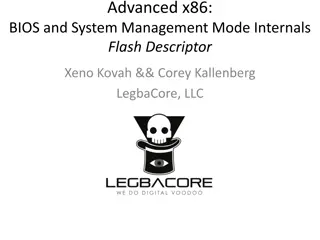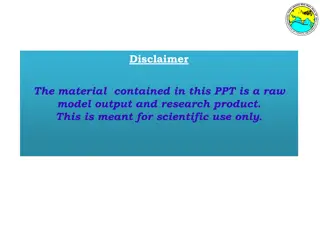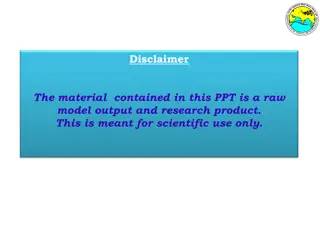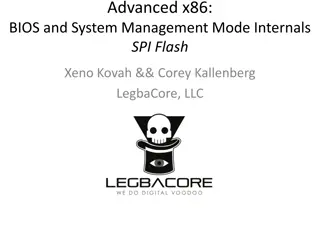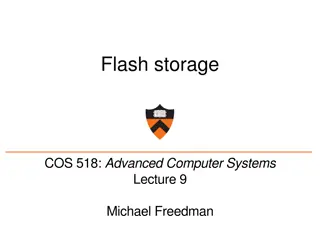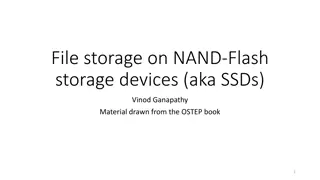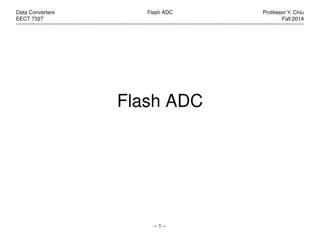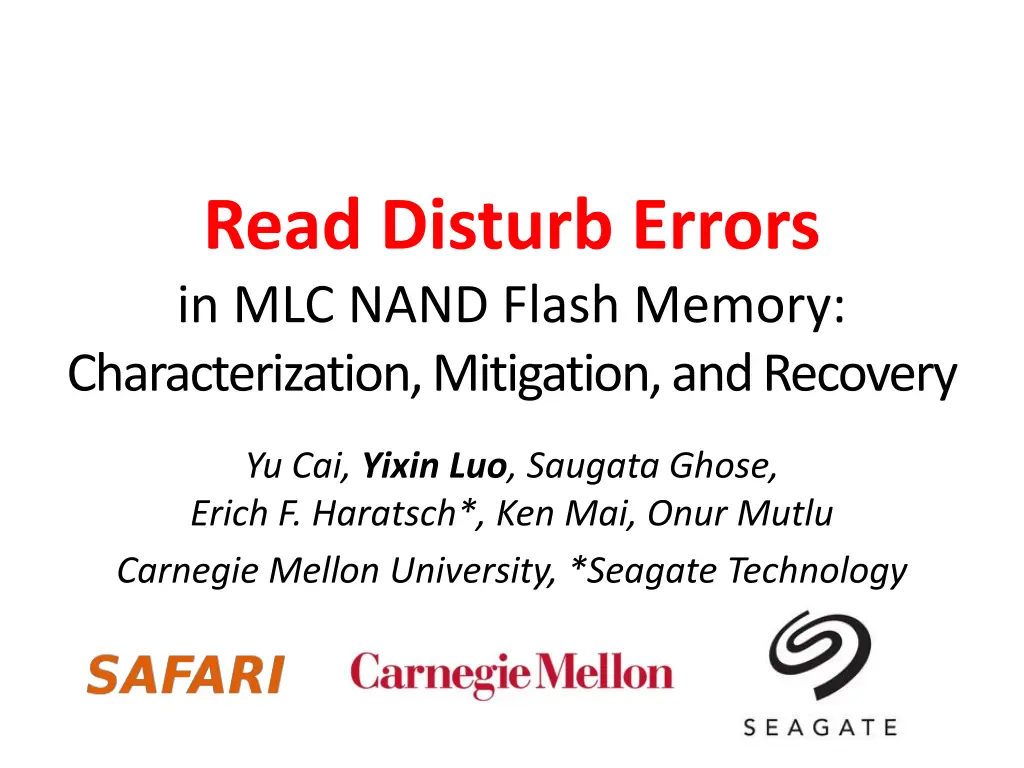
Understanding Read Disturb Errors in MLC NAND Flash Memory
Learn about the characterization, mitigation, and recovery of read disturb errors in MLC NAND flash memory. Discover techniques to mitigate errors and recover data effectively, enhancing flash memory lifetime.
Download Presentation

Please find below an Image/Link to download the presentation.
The content on the website is provided AS IS for your information and personal use only. It may not be sold, licensed, or shared on other websites without obtaining consent from the author. If you encounter any issues during the download, it is possible that the publisher has removed the file from their server.
You are allowed to download the files provided on this website for personal or commercial use, subject to the condition that they are used lawfully. All files are the property of their respective owners.
The content on the website is provided AS IS for your information and personal use only. It may not be sold, licensed, or shared on other websites without obtaining consent from the author.
E N D
Presentation Transcript
Read Disturb Errors in MLC NAND Flash Memory: Characterization, Mitigation, and Recovery Yu Cai, Yixin Luo, Saugata Ghose, Erich F. Haratsch*, Ken Mai, Onur Mutlu Carnegie Mellon University, *Seagate Technology
Executive Summary Read disturb errors limit flash memory lifetime today Apply a high pass-through voltage (Vpass)to multiple pages on a read We characterize read disturb on real NAND flash chips Slightly lowering Vpassgreatly reduces read disturb errors Some flash cells are more prone to read disturb Technique 1: Mitigate read disturb errors online VpassTuning dynamically finds and applies a lowered Vpass Flash memory lifetime improves by 21% Technique 2: Recover after failure to prevent data loss Read Disturb Oriented Error Recovery (RDR) selectively corrects cells more susceptible to read disturb errors Reduces raw bit error rate (RBER) by up to 36% 2
Outline Background (Problem and Goal) Key Experimental Observations Mitigation: Vpass Tuning Recovery: Read Disturb Oriented Error Recovery Conclusion 3
Outline Background (Problem and Goal) Key Experimental Observations Mitigation: Vpass Tuning Recovery: Read Disturb Oriented Error Recovery Conclusion 4
NAND Flash Memory Background Flash Memory Page 256 Read Page 0 Page M Page 257 Pass Pass Page 1 Page M+1 Page 2 Page 258 Page M+2 Block 0 Block 1 Block N Page 511 Pass Page 255 Page M+255 Flash Controller 5
Flash Cell Array Row Block X Page Y Column Sense Amplifiers Sense Amplifiers 6
Flash Cell Drain Floating Gate Gate Vth = 2.5 V Source Floating Gate Transistor (Flash Cell) 7
Flash Read Vread = 2.5 V Vread = 2.5 V Vth = 2 V Vth = 3 V Gate 1 0 8
Flash Pass-Through Vpass = 5 V Vpass = 5 V Vth = 2 V Vth = 3 V Gate 1 1 9
Read from Flash Cell Array Vpass = 5.0 V 3.8V Pass (5V) 3.0V 3.9V 4.8V Page 1 Vread = 2.5 V 2.9V Read (2.5V) 3.5V 2.4V 2.1V Page 2 Vpass = 5.0 V 4.3V Pass (5V) 2.2V 4.6V 1.8V Page 3 Vpass = 5.0 V 2.3V Pass (5V) 3.5V 1.9V 4.3V Page 4 Correct values for page 2: 0 0 1 1 10
Read Disturb Problem: Weak Programming Effect 3.8V Pass (5V) 3.0V 3.9V 4.8V Page 1 2.9V Pass (5V) 3.5V 2.4V 2.1V Page 2 4.3V Read (2.5V) 2.2V 4.6V 1.8V Page 3 2.3V Pass (5V) 3.5V 1.9V 4.3V Page 4 Repeatedly read page 3 (or any page other than page 2) 11
Read Disturb Problem: Weak Programming Effect Vpass = 5.0 V 3.0V 3.8V 3.9V 4.8V Page 1 Vread = 2.5 V 3.5V 2.9V 2.4V 2.6V 2.1V Page 2 Vpass = 5.0 V 2.2V 4.3V 4.6V 1.8V Page 3 Vpass = 5.0 V 3.5V 2.3V 1.9V 4.3V Page 4 Incorrect values from page 2: 0 0 0 1 High pass-through voltage induces weak-programming effect 12
Read disturb errors: Reading from one page can alter the values stored in other unread pages Goal: Mitigate and Recover Read Disturb Errors 13
Outline Background (Problem and Goal) Key Experimental Observations Mitigation: Vpass Tuning Recovery: Read Disturb Oriented Error Recovery Conclusion 14
Methodology FPGA-based flash memory testing platform [Cai+, FCCM 11] Real 20- to 24-nm MLC NAND flash chips 0 to 1M read disturbs 0 to 15K Program/Erase Cycles (PEC) 15
Read Disturb Effect on Vth Distribution 10-3 6 Vth gradually increases with read disturb counts 0 (No Read Disturbs) 0.25M Read Disturbs 0.5M Read Disturbs 1M Read Disturbs 5 4 PDF 3 P1 state P2 state P3 state 2 1 ER state 00 50 100 150 200 250 300 350 400 450 500 Normalized Threshold Voltage 16
Other Experimental Observations Lower threshold voltage states are affected more by read disturb Wear-out increases read disturb effect 17
Reducing The Pass-Through Voltage Key Observation 1: Slightly lowering Vpass greatly reduces read disturb errors 1400 1300 1200 Normalized Tolerable Read Disturb Count 1000 800 600 470 400 200 100 22 6.8 1.7 1 0 0% 1% 2% 3% 4% 5% 6% Percentage of Vpass Reduction 18
Outline Background (Problem and Goal) Key Experimental Observations Mitigation: Vpass Tuning Recovery: Read Disturb Oriented Error Recovery Conclusion 19
Read Disturb Mitigation: Vpass Tuning Key Idea: Dynamically find and apply a lowered Vpass Trade-off for lowering Vpass +Allows more read disturbs Induces more read errors 20
Read Errors Induced by Vpass Reduction Reducing Vpass to 4.9V Vpass = 4.9 V 3.0V 3.8V 3.9V 4.8V Page 1 Vread = 2.5 V 3.5V 2.9V 2.4V 2.1V Page 2 Vpass = 4.9 V 2.2V 4.3V 4.6V 1.8V Page 3 Vpass = 4.9 V 3.5V 2.3V 1.9V 4.3V Page 4 0 0 1 1 21
Read Errors Induced by Vpass Reduction Reducing Vpass to 4.7V Vpass = 4.7 V 3.0V 3.8V 3.9V 4.8V Page 1 Vread = 2.5 V 3.5V 2.9V 2.4V 2.1V Page 2 Vpass = 4.7 V 2.2V 4.3V 4.6V 1.8V Page 3 Vpass = 4.7 V 3.5V 2.3V 1.9V 4.3V Page 4 Incorrect values from page 2: 0 0 1 0 22
Utilizing the Unused ECC Capability ECC Correction Capability 10-3 1.0 Unused ECC capability 0.8 RBER 0.6 0.4 0.2 0 01 02 03 04 05 06 07 08 09 10 11 12 13 14 15 16 17 18 19 20 21 N-day Retention 1. Huge unused ECC correction capability can be used to tolerate read errors 2. Unused ECC capability decreases over time Dynamically adjust Vpass so that read errors fully utilize the unused ECC capability 23
Vpass Reduction Trade-Off Summary Conservatively set Vpass to a high voltage Accumulates more read disturb errors at the end of each refresh interval +No read errors Dynamically adjust Vpass to unused ECC capability +Minimize read disturb errors oControl read errors to be tolerable by ECC oIf read errors exceed ECC capability, read again with a higher Vpass to correct read errors 24
Vpass Tuning Steps Perform once for each block every day: 1. Estimate unused ECC capability 2. Aggressively reduce Vpass until read errors exceeds ECC capability 3. Gradually increase Vpass until read error just becomes less than ECC capability 25
Evaluation of Vpass Tuning 19 real workload I/O traces Assume 7-day refresh period Similar methodology as before to determine acceptable Vpass reduction Overhead for a 512 GB flash drive: 128 KB storage overhead for per-block Vpass setting and worst-case page 24.34 sec/day average Vpass Tuning overhead 26
Vpass Tuning Lifetime Improvements Vpass Tuning Vpass Tuning Baseline P/E Cycle Lifetime 12000 10000 8000 6000 4000 2000 0 rsrch proj src stg prn ts wdev homes web-vm mds web usr postmark hm prxy mail cello99 webSearch financial Average lifetime improvement: 21.0% 27
Outline Background (Problem and Goal) Key Experimental Observations Mitigation: Vpass Tuning Recovery: Read Disturb Oriented Error Recovery Conclusion 28
Read Disturb Resistance PDF N read disturbs Disturb-Resistant R R N read disturbs Disturb-Prone P P Normalized Vth 29
Observation 2: Some Flash Cells Are More Prone to Read Disturb After 250K read disturb: PDF Disturb-prone cells have higher threshold voltages Disturb-resistant cells have lower threshold voltages ER P1 R R P P P P Disturb-resistant P1 state Disturb-prone ER state P P P P R R Normalized Vth 30
Read Disturb Oriented Error Recovery (RDR) Triggered by an uncorrectable flash error Back up all valid data in the faulty block Disturb the faulty page 100K times (more) Compare Vth s before and after read disturb Select cells susceptible to flash errors (Vref <Vth<Vref ) Predict among these susceptible cells Cells with more Vth shifts are disturb-prone Higher Vth state Cells with less Vth shifts are disturb-resistant Lower Vth state 31
RDR Evaluation 10-3 12 10 RDR No Recovery 8 6 4 2 0 RBER 0 0.2M 0.4M 0.6M 0.8M 1M Read Disturb Count Reduce total error counts up to 36% @ 1M read disturbs ECC can be used to correct the remaining errors 32
Outline Background (Problem and Goal) Key Experimental Observations Mitigation: Vpass Tuning Recovery: Read Disturb Oriented Error Recovery Conclusion 33
Executive Summary Read disturb errorslimit flash memory lifetime today Apply a high pass-through voltage (Vpass) to multiple pages on a read We characterize read disturb on real NAND flash chips Slightly lowering Vpass greatly reduces read disturb errors Some flash cells are more prone to read disturb Technique 1: Mitigate read disturb errors online Vpass Tuning dynamically finds and applies a lowered Vpass Flash memory lifetime improves by 21% Technique 2: Recover after failure to prevent data loss Read Disturb Oriented Error Recovery (RDR) selectively corrects cells more susceptible to read disturb errors Reduces raw bit error rate(RBER) by up to 36% 34
Read Disturb Errors in MLC NAND Flash Memory: Characterization, Mitigation, and Recovery Yu Cai, Yixin Luo, Saugata Ghose, Erich F. Haratsch*, Ken Mai, Onur Mutlu Carnegie Mellon University, *Seagate Technology

